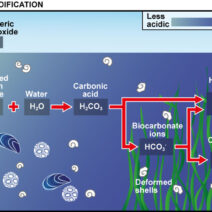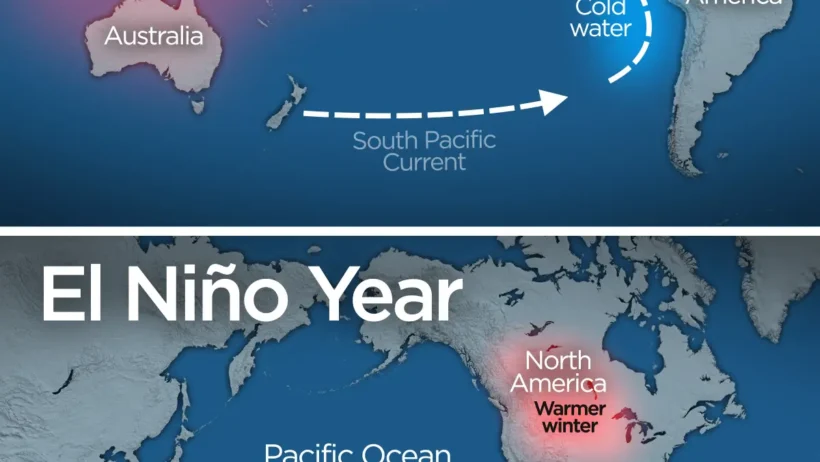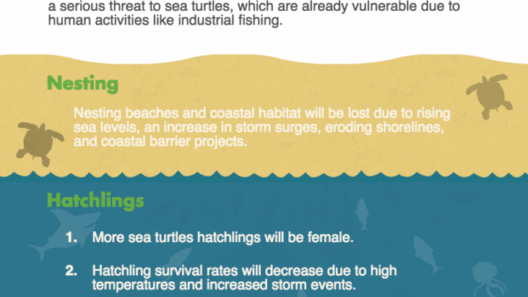El Niño is an intricate natural phenomenon that exemplifies the intricate interplay between ocean currents and global climate systems. This climatic event, characterized by the anomalous warming of ocean waters in the equatorial Pacific, offers a compelling glimpse into the dynamics of our planet’s climate. Understanding El Niño not only illuminates its immediate consequences but also unveils broader implications for climate patterns around the globe.
The genesis of El Niño is rooted in the trade winds—powerful breezes that typically blow from east to west across the tropical Pacific. Under normal circumstances, these winds push warm surface waters toward the western Pacific, causing cooler, nutrient-rich waters to upwell along the South American coast. This regular pattern sustains vital marine ecosystems and fosters abundant fisheries. However, periodic weakening of these trade winds allows warmer waters to accumulate in the eastern Pacific, thus heralding the onset of El Niño.
This not only leads to significant fluctuations in marine biodiversity but also triggers a cascade of atmospheric changes, which manifest as erratic weather patterns across the globe. The alterations in ocean temperatures affect atmospheric pressure systems, resulting in phenomena such as droughts in some regions and torrential rains in others. For instance, during an El Niño event, parts of the southwestern United States may experience increased precipitation, while places like Indonesia and Australia may suffer from drought conditions.
The unpredictability and variability of El Niño events render long-term forecasting exceedingly challenging. Historically, societies have grappled with the ramifications of such climatic irregularities—ranging from agricultural failures to unprecedented flooding. This emphasizes the pressing need for robust climate models that can enhance our predictive capabilities. Indeed, scientists have begun employing cutting-edge technology and data analytics to improve our understanding of El Niño’s dynamics. Employing satellite observations, ocean buoys, and advanced computer models, researchers are making strides in decoding the complex interactions that define this phenomenon.
One of the most captivating aspects of El Niño is its capacity to reshape climatic conditions in places far removed from the Pacific itself. The interconnection of ocean and atmosphere displays a fascinating web of causation. For example, El Niño can disrupt the monsoon patterns in India, leading to a dramatic reduction in rainfall and, consequently, agricultural hardship. Similarly, countries in the southeastern United States may grapple with intensified storm systems, increasing the threat posed by hurricanes and flooding.
The impacts of El Niño extend beyond meteorological effects; they ripple through economic structures as well. Agriculture, fishing, and water resources are all profoundly influenced by the behavioral tendencies of this climatic anomaly. Farmers must adapt to shifting agricultural zones, while fishermen may experience a decline in species abundance due to altered oceanic conditions. Consequently, nations must prepare and strategize for resilience in the face of such climatic unpredictability.
Moreover, the relationship between El Niño and climate change raises crucial questions for future generations. As global temperatures continue to rise due to anthropogenic influences, it remains uncertain how the frequency and intensity of El Niño events may shift. While the natural variability of the phenomenon is well-documented, emerging research suggests that climate change could exacerbate the conditions conducive to El Niño, potentially leading to more extreme weather patterns.
This juncture—where traditional observations of El Niño meet the realities of a warming planet—invites a paradigm shift. It challenges us to rethink our approach to environmental stewardship. The interconnectedness inherent in the Earth’s systems underscores the necessity for a holistic understanding of climate dynamics. Policymakers must consider the intricate balance of ocean temperatures, wind patterns, and atmospheric responses when devising strategies to combat climate-related challenges.
Furthermore, the implications of El Niño stress the importance of community resilience. From urban planning to agricultural practices, local communities can benefit from enhanced awareness and preparedness strategies. Engaging with indigenous knowledge systems that have historically navigated climatic variability can yield valuable insights for contemporary adaptation strategies. Collaborative projects that integrate scientific research with local wisdom can empower communities to withstand the impacts of El Niño and cultivate a more sustainable future.
In tandem with these local efforts, international collaboration is paramount. Climate change knows no borders, and the convoluted web of ocean-atmosphere interactions means that one region’s problem can swiftly become another’s crisis. Strengthening global partnerships to share data, resources, and strategies is essential for addressing the multifaceted challenges posed by El Niño. By fostering a collective commitment to understanding our planet’s climatic systems, we can work towards mitigating adverse outcomes and enhancing our collective resilience.
As we delve deeper into the intricacies of El Niño, it becomes evident that this climatic phenomenon is more than a mere atmospheric curiosity; it embodies the profound interplay between our oceans and climate systems. Its impacts resonate across continents, economically and environmentally, shaping the very fabric of society. Acknowledging the complexities inherent in this phenomenon paves the way for a more informed, proactive approach to climate change, encouraging us to reflect on our place within the greater environmental tapestry.
Ultimately, understanding El Niño signifies a commitment to interpreting climate not solely through a lens of doom and gloom but as a series of interconnected systems ripe for exploration and understanding. As we cultivate curiosity about the nuances of our planet’s climate, we enhance our capacity to adapt, innovate, and thrive in an increasingly unpredictable world.





